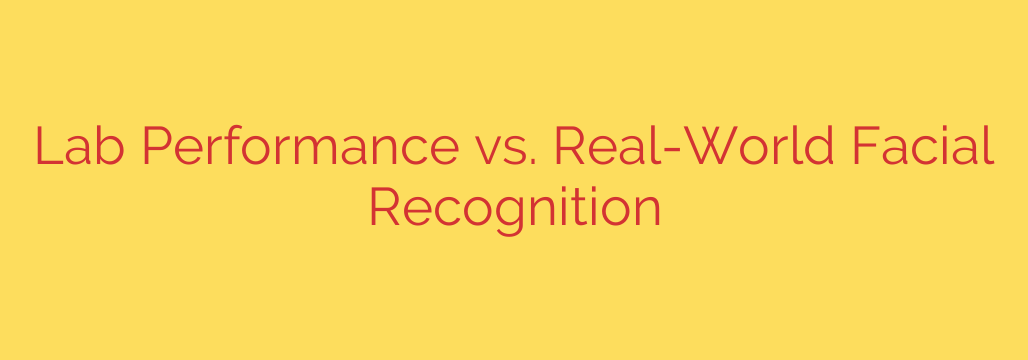
The Reality of Facial Recognition: Why Lab Accuracy Doesn’t Translate to the Real World
Facial recognition technology is everywhere. It unlocks our smartphones, tags friends in photos, and streamlines security at airports. We often hear staggering claims of its accuracy—sometimes exceeding 99%. While these numbers are impressive, they typically come from tests conducted in pristine, controlled laboratory settings. The reality is that once these systems are deployed in the messy, unpredictable real world, their performance can change dramatically.
Understanding the gap between lab performance and real-world application is crucial for anyone relying on this technology for security, convenience, or public safety.
The Ideal World: Facial Recognition in the Lab
When developers and researchers test facial recognition algorithms, they use standardized datasets under ideal conditions. This controlled environment typically includes:
- High-Quality Images: Photos are high-resolution, well-lit, and taken with professional-grade cameras.
- Cooperative Subjects: Individuals are looking directly at the camera with a neutral expression, similar to a passport photo.
- Minimal Obstructions: Faces are clear of sunglasses, hats, heavy makeup, or shadows.
In this perfect scenario, algorithms can easily map facial features and achieve near-perfect accuracy rates. These lab results are essential for benchmarking and comparing different algorithms, but they don’t represent how the technology will perform on a busy street or in a dimly lit building.
The Four Major Challenges of Real-World Deployment
When facial recognition systems leave the lab, they face a host of variables that significantly impact their accuracy. These challenges can lead to critical errors, including failing to identify a known person (a false negative) or misidentifying an innocent person (a false positive).
1. Poor and Unpredictable Lighting
Lighting is one of the most significant hurdles. Unlike the balanced, frontal lighting of a lab, the real world is full of shadows, glare, backlighting, and low-light conditions. Harsh shadows can obscure key facial features like the eyes and nose, making it difficult for an algorithm to find a match. Similarly, dim lighting can reduce image quality and detail, leading to inaccurate results.
2. Variations in Pose, Angle, and Expression
People rarely look directly at a surveillance camera. They are often in motion, with their heads tilted, turned to the side, or looking up or down. Most facial recognition systems are trained on frontal face images, so their accuracy drops sharply when presented with a profile or angled view. Facial expressions like smiling, frowning, or talking also alter the geometry of the face, further complicating the matching process.
3. Obstructions and Occlusions
In everyday life, faces are often partially hidden. Common obstructions include:
- Hats and scarves
- Sunglasses or prescription glasses
- Facial hair
- Hair falling across the face
- Face masks
Even a hand raised to the face can be enough to block critical data points, causing the system to fail. While some advanced algorithms are getting better at handling occlusions, it remains a major challenge.
4. The Critical Issue of Demographic Bias
Perhaps the most serious concern is demographic bias. Facial recognition algorithms are trained on massive datasets of images. If these datasets are not diverse, the resulting system will be less accurate for underrepresented groups.
Extensive studies have repeatedly shown that many facial recognition systems are less accurate for women, people of color, and the elderly. This is because the training data is often overwhelmingly composed of images of white men. This bias can have severe consequences, leading to higher rates of misidentification for already marginalized communities.
Practical Security Implications and Actionable Advice
The gap between lab and real-world performance isn’t just an academic issue; it has profound security implications. An over-reliance on imperfect technology can create a false sense of security or, worse, lead to wrongful accusations.
Here are some key takeaways and security tips:
- Treat Facial Recognition as One Tool, Not the Only Tool: For critical security applications, facial recognition should be used as part of a multi-layered approach. It can be a useful signal, but it should be verified by a human operator or another security measure.
- Understand the Risk of False Positives and Negatives: Be aware that a system failing to flag a person of interest (false negative) is a security breach, while incorrectly flagging an innocent person (false positive) can have devastating personal consequences.
- Promote Responsible AI Development: Organizations developing or deploying this technology must prioritize testing their systems on diverse, real-world data, not just sanitized lab datasets. Auditing for and actively mitigating demographic bias is essential.
- For Personal Security, Quality Matters: When using facial recognition to unlock your personal devices, ensure you enroll your face in good, even lighting. Re-enroll your face if you significantly change your appearance (e.g., grow a beard or start wearing glasses). For sensitive accounts, always enable multi-factor authentication (MFA) instead of relying solely on a biometric unlock.
Facial recognition is a powerful technology with immense potential, but its limitations must be understood and respected. As it becomes more integrated into our lives, demanding transparency, accuracy, and fairness in its real-world application is more important than ever.
Source: https://go.theregister.com/feed/www.theregister.com/2025/08/18/facial_recognition_benchmarks/







